Sarah Sundin's Blog, page 257
June 15, 2017
Victory Mail in World War II
 Letters in World War II
Letters in World War IIDuring World War II, letters were essential to the health of a relationship. Soldiers and sailors who shipped overseas couldn’t make phone calls, and of course, e-mails and text messages hadn’t been invented. That left letters.
The average soldier wrote six letters a week. Those letters took anywhere from 1-4 weeks to cross the ocean to the United States. Each letter received at home assured loved ones that their serviceman was still alive and well when he wrote that letter. And each letter received on the front reminded that serviceman why he was fighting.
Victory Mail
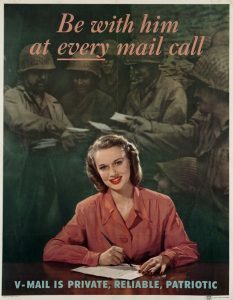
The US military knew that letters from home were the single biggest morale booster, and a force with high morale fights better. However, mail bags took up valuable space on cargo ships and planes. For example, in 1945 the US Army handled over 2 billion pieces of mail.
The solution was Victory Mail, or V-Mail. Letters written on pre-printed forms were photographed and reproduced onto microfilm. The rolls of microfilm were transported overseas, where the letters were printed again at one-quarter size and mailed to their destination.
V-Mail was never mandatory, but it was successful. A letter on microfilm took up about one-thirty-seventh of the space of the same letter on paper. In the first two years of the program, the military estimated that V-Mail saved room for 5 million pounds of cargo.
V-Mail Stationery
V-Mail stationery was a single page, printed front and back. The back contained instructions as well as space for return and mailing addresses. The letter was written on the front within the margins, boldly and in dark ink so it would reproduce well. The return and mailing addresses were repeated at the top. The form was folded in half, sealed, and sent off.
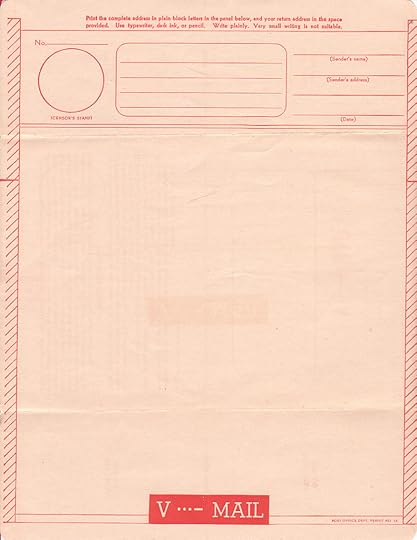
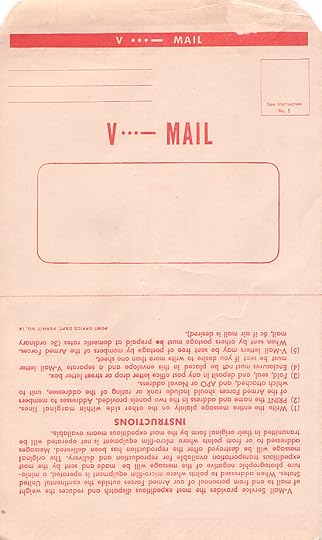
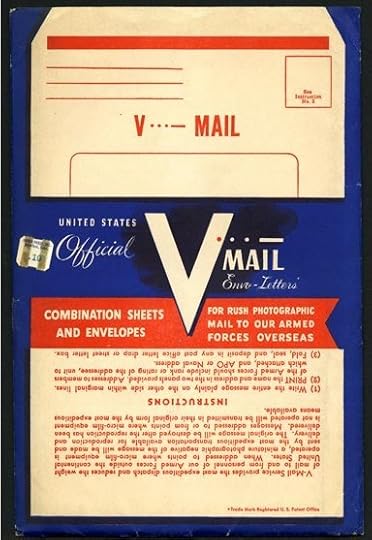
V-Mail Processing
At the V-Mail processing center, each letter was censored and photographed. The original letters were stored until confirmation was received that the shipment had been received—a nice insurance policy in case a cargo ship was sunk by a U-boat or a cargo plane went down in bad weather.
V-Mail had its disadvantages. Letters had to be short. No enclosures were possible. The scent of perfume did not photograph. And lipstick prints gummed up the scanning machines—dubbed the “Scarlet Scourge” by postal workers.
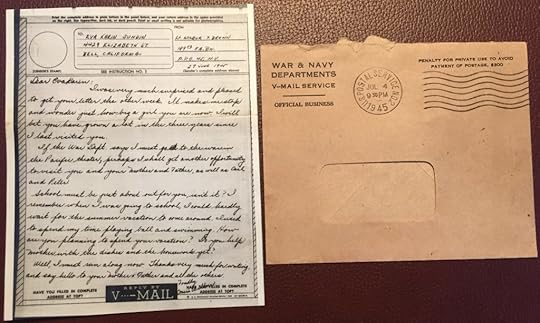
A V-Mail received by my husband’s aunt during World War II. Note smaller size in relation to envelope.
Victory mail and regular letters helped couples communicate. The danger of wartime lent urgency to correspondence. No one knew if that letter was the last one they’d write or receive. Couples regularly expressed feelings usually saved for special occasions.
My source for this post was the excellent on-line display on V-Mail at the Smithsonian Postal Museum: http://www.postalmuseum.si.edu/VictoryMail



Today in World War II History—June 15, 1942
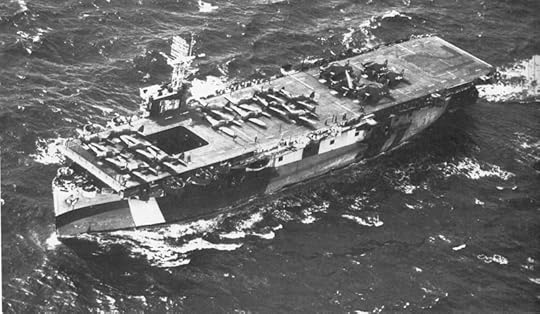
Escort carrier USS Copahee with a load of captured Japanese planes, 8 July 1944 (US Navy photo)
75 Years Ago—June 15, 1942: USS Copahee commissioned as first Bogue-class auxiliary carrier, converted from a merchant ship.
US nationwide rubber scrap drive begins; will bring in 450,000 tons. (See: “Make It Do—Scrap Drives in World War II”)
US institutes V-Mail system to microfilm overseas mail and maximize shipping space. (See: “Victory Mail in World War II”)
June 14, 2017
Book Beat – Grounded Hearts by Jeanne Dickson
 When Canadian “Dutch” Whitney bails out of his damaged RAF bomber in February 1941, he’s glad to land on solid ground…alive. But he’s landed in neutral Ireland and by law, he’ll be interned in an Irish camp for the duration of the war. Somehow he needs to make his way across the border to Northern Ireland so he can return to duty.
When Canadian “Dutch” Whitney bails out of his damaged RAF bomber in February 1941, he’s glad to land on solid ground…alive. But he’s landed in neutral Ireland and by law, he’ll be interned in an Irish camp for the duration of the war. Somehow he needs to make his way across the border to Northern Ireland so he can return to duty.
Widowed midwife Nan O’Neill is stunned to find an injured pilot at her cottage door. And a shockingly attractive pilot at that. Her duties as a nurse require her to tend his wounds, but her duties as an Irishwoman require her to turn Dutch in to the Garda for internment. Her compassion prevails, and she hides Dutch in her cottage while he heals. But when Nan attempts to get her car fixed so Dutch can escape, will she unwittingly alert the villagers to her secret flyboy?
Grounded Hearts by Jeanne Dickson is a romantic and compelling tale. The details on wartime life in neutral Ireland are fascinating, and the village is filled with a charmingly humorous populace. Dutch and Nan are appealing characters with depth, and their relationship sizzles as they both find healing. Exciting, romantic, funny…don’t miss Grounded Hearts! I loved this book.
Today in World War II History—June 14, 1942
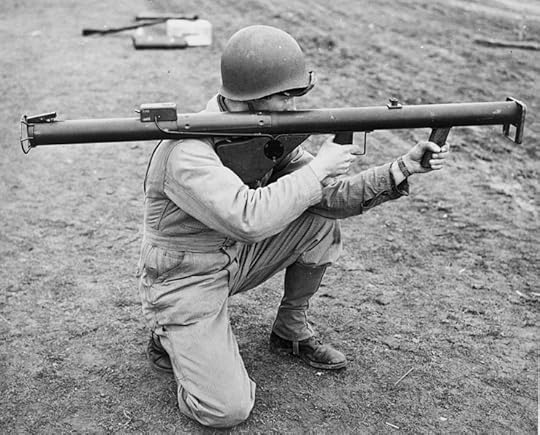
Soldier holding an M1 “Bazooka,” 1943 (Library of Congress)
75 Years Ago—June 14, 1942: Germans take Fort Stalin at Sevastopol.
First firing of bazooka, at Bridgeport, Connecticut.
German saboteur George Dasch, who had landed in New York by U-boat the day before, calls the FBI, turning himself in.
June 13, 2017
Today in World War II History—June 13, 1942
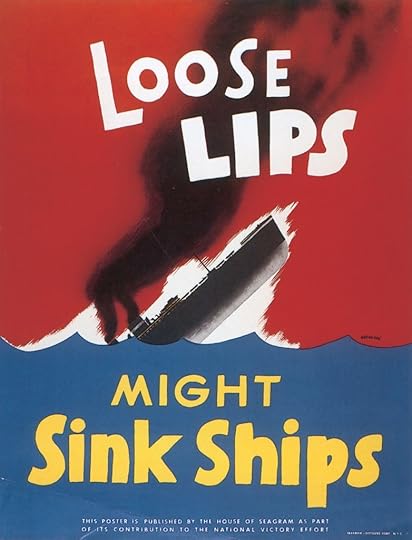 75 Years Ago—June 13, 1942: Rommel defeats British at Knightsbridge in Libya; heavy British casualties on “Black Saturday.”
75 Years Ago—June 13, 1942: Rommel defeats British at Knightsbridge in Libya; heavy British casualties on “Black Saturday.”
US forms Office of Strategic Services (OSS), precursor of CIA.
US forms Office of War Information to oversee radio, movies, press, and to disseminate propaganda.
Four German saboteurs are landed by U-202 at Amagansett, Long Island, just after midnight.
June 12, 2017
Make It Do – Scrap Drives in World War II
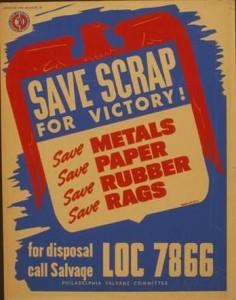
Perhaps nothing represents the community-minded patriotism of the US Home Front in World War II better than the scrap drive.
Seventy-five years ago, the United States began its first major national scrap drive – for rubber.
Enemy conquests cut off supplies of crucial raw materials such as tin and rubber, and the need for products made from these materials skyrocketed due to the war. Since useful materials often ended up in the trash can or languished unused in homes and on farms, the War Production Board encouraged scrap drives throughout the war.
Rubber Drive
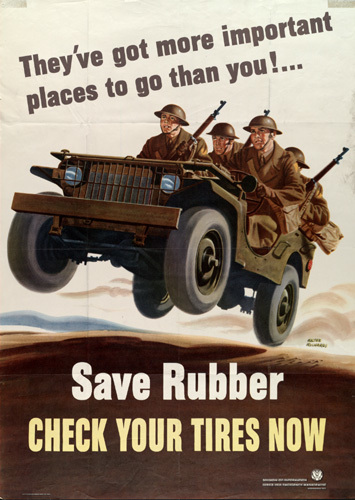
Rubber was vital for war use, and acute shortages affected the United States from early in the war (See “Make It Do – Tire Rationing in World War II”). From June 15-30, 1942, the United States held a nationwide rubber drive. People brought in old or excess tires, raincoats, hot water bottles, boots, and floor mats. In exchange they received a penny a pound. Although 450,000 tons of scrap rubber was collected, used rubber was found to be of poor quality.
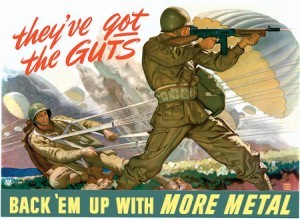
Scrap Metal Drives
Metal shortages were also critical (Make It Do – Metal Shortages in World War II). In 1942 citizens scoured their homes, farms, and businesses for metal. Housewives donated pots and pans, farmers turned in farm equipment, and children even sacrificed their metal toys. Many people removed bumpers and fenders from their cars for the war effort. Communities melted down Civil War cannons and tore down wrought iron fences, sacrificing their history for their future.
These drives were often great community events, with performers, speeches, and opportunities to throw your scrap metal at a bust of Hitler.
Competitions were held to see which town, county, and state produced the most scrap, and the winners boasted of their feats. These drives had mixed results. Used aluminum was found to be useless for aircraft, but used tin, steel, and copper were easily melted down and reused.
Tin Can Drives

The use of tin packaging was greatly reduced during the war, due to the use of alternative packaging materials and to rationing of canned goods. However, consumer use of tin continued throughout the war, and this irreplaceable resource needed to be recovered.
Most communities collected tin cans once a month. In some towns, people places boxes of cleaned and crushed tin cans by the curb for collection, and other towns had central collection sites. Youth groups, especially the Boy Scouts, were highly involved in these drives.
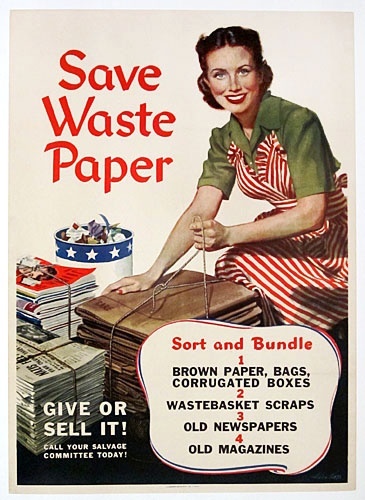 Paper Drives
Paper DrivesThe need for paper increased during the war. The military’s love for paperwork could be blamed, but the military also used lots of paper packaging for supplies. On the civilian side, paper packaging had replaced tin for many products.
A paper drive in mid-1942 brought in so much paper that mills were inundated and actually called for a stop. However, by 1944 an acute paper shortage existed.
The lumber industry was hard-hit by the manpower shortage caused by the draft. Lumberjacks went on strike, demanding a higher meat ration, which they did not receive. Many of these men left for higher-paying jobs in the defense industry.
Publishers found their paper allotment cut by 15 percent. Newspapers, magazines, and books were printed on fewer pages with thinner paper and narrow margins. Paperback books had been introduced in 1939 and also allowed for less paper. However, more scrap paper was needed.
The children of America stepped up. The Boy Scouts and local schools organized regular paper drives, often coordinated with the tin can drives. The War Production Board started the Paper Troopers program, designed to sound like “paratroopers,” to involve schoolchildren in the effort. Participants received arm patches and certificates for collecting certain amounts.
Results
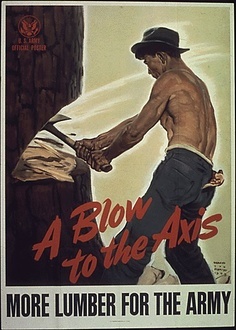
Scrap drives were a vital part of the American war effort. While not all scrap materials proved useful, many did and provided a small but significant source of material. Most importantly, these drives galvanized the Home Front and made each individual, even children, feel like a crucial part of the war effort.
Today in World War II History—June 12, 1942
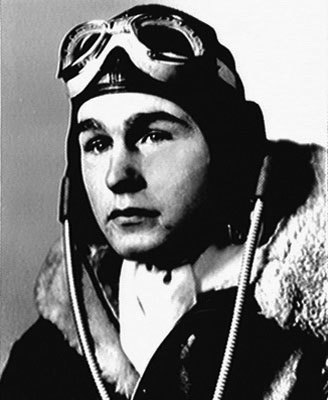
US Navy pilot Lt. George H.W. Bush, WWII (US Navy photo)
75 Years Ago—June 12, 1942: Anne Frank receives a diary for her thirteenth birthday.
On his 18th birthday, future president George H.W. Bush graduates from high school and enlists in the Navy, although he’d already been accepted at Yale.
US B-24 Liberator bombers flying from Egypt attack Ploesti in first US strategic mission of war in the European-African-Middle East Theater.
US 100th Infantry Battalion activated, composed of Japanese-Americans from Hawaii.
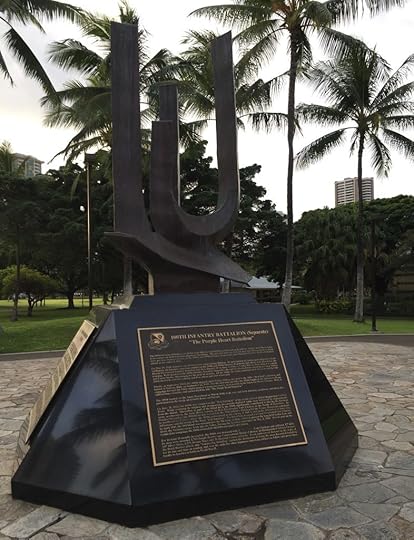
Brothers in Valor Monument in Honolulu, HI, commemorating the 100th Infantry Battalion and other Japanese-American units in World War II (Photo: Sarah Sundin, November 2016)
June 11, 2017
Today in World War II History—June 11, 1942
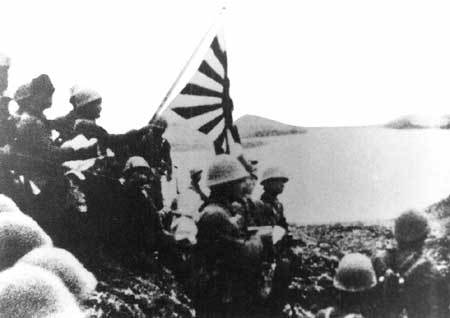
Japanese Special Naval Landing Force on Kiska in Aleutian Islands, 6 Jun 1942 (public domain via WW2 Database)
75 Years Ago—June 11, 1942: German forces under Rommel break out of siege in “The Cauldron” near Gazala, Libya and attack near Knightsbridge.
Free French evacuate Bir Hacheim in Libya, Germans occupy fort.
US Eleventh AF in Alaska begins bombing Japanese-held Kiska in the Aleutians.
US Navy planes discover Japanese presence on Attu in the Aleutians, and US Navy PBY Catalinas bomb those positions.
June 10, 2017
Today in World War II History—June 10, 1942
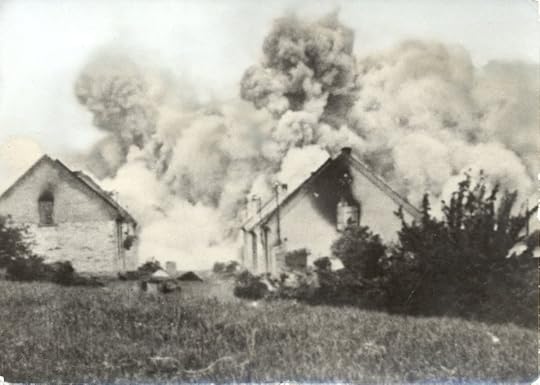
Houses of Lidice, Czechoslovakia burning, 10 Jun 1942 (public domain via WW2 Database)
75 Years Ago—June 10, 1942: Germans destroy Czechoslovakian town of Lidice in retaliation for SS Gen. Heydrich’s death, killing all 173 men and deporting the children and women to concentration camps.
British tea planter uses elephants to rescue 68 Burmese refugees fleeing Japanese across the Daphna River, India.
US approves construction of “Big Inch” pipeline to transport crude oil from Texas to northeast states, bypassing U-boats.
June 9, 2017
Book Beat – Road to Harmony by Sherry Kyle
 A cattle rustler is wreaking havoc in California’s Harmony Valley, but the last thing Elena Seifert expects to find in her trap is her childhood love, Jonas Bollinger. After Jonas abandoned his family farm to chase his dreams, Elena made the best of things, helping her parents on the dairy farm and with her mentally challenged brother. And Elena’s moved on, expecting a proposal from Lars Rissler, a prosperous shopkeeper.
A cattle rustler is wreaking havoc in California’s Harmony Valley, but the last thing Elena Seifert expects to find in her trap is her childhood love, Jonas Bollinger. After Jonas abandoned his family farm to chase his dreams, Elena made the best of things, helping her parents on the dairy farm and with her mentally challenged brother. And Elena’s moved on, expecting a proposal from Lars Rissler, a prosperous shopkeeper.
Jonas is determined to make things right with his family, going as far as to accept his father’s deathbed wish – which goes against the dreams of his heart.
Road to Harmony by Sherry Kyle is a sweet story of duty and expectations, promises and love, set in the picturesque Harmony Valley in 1907. The writing is warm and personal, and the characters are real and engaging, as they struggle with cattle rustlers and matters of the heart. I strongly recommend this lovely novel!



